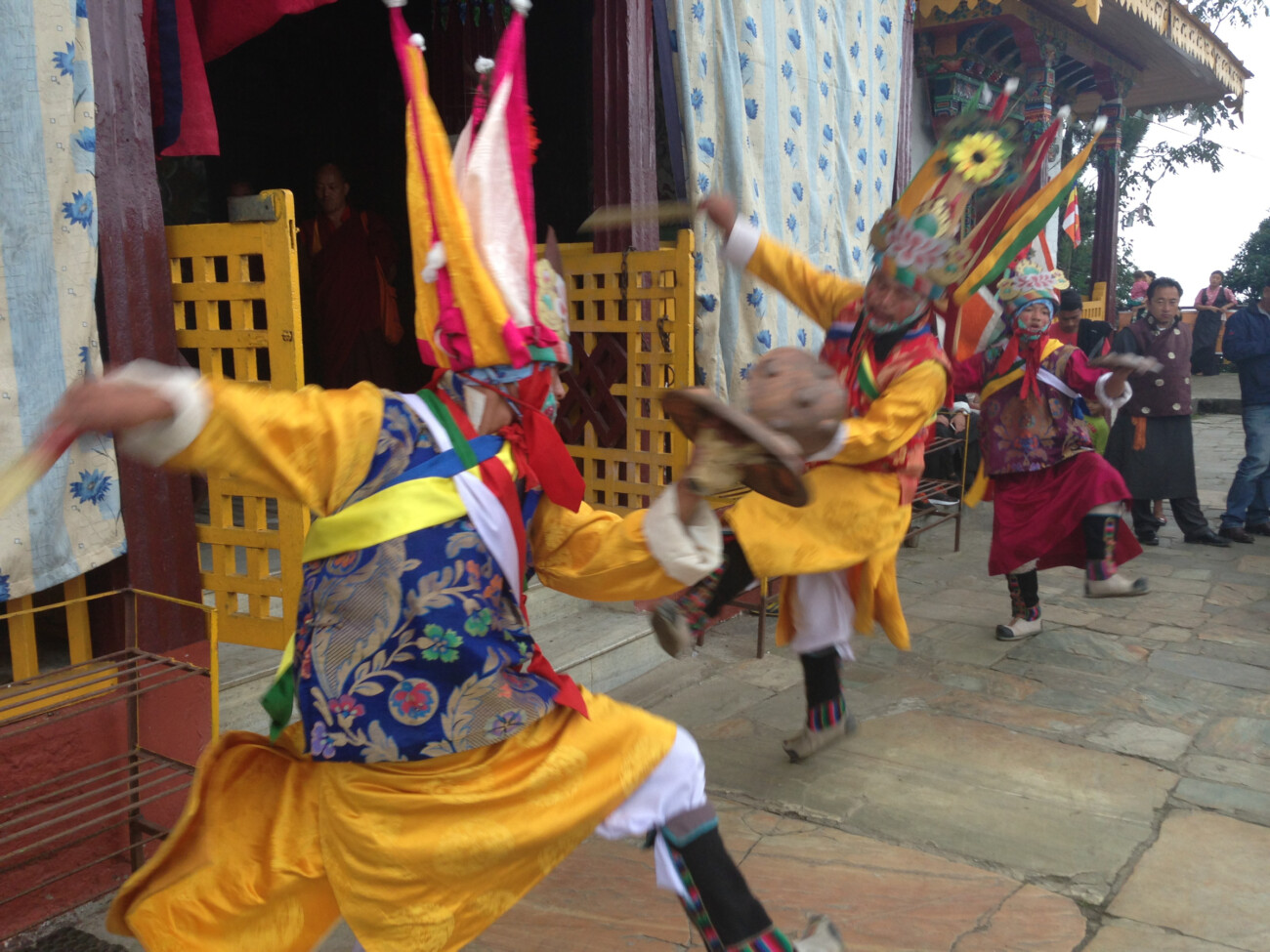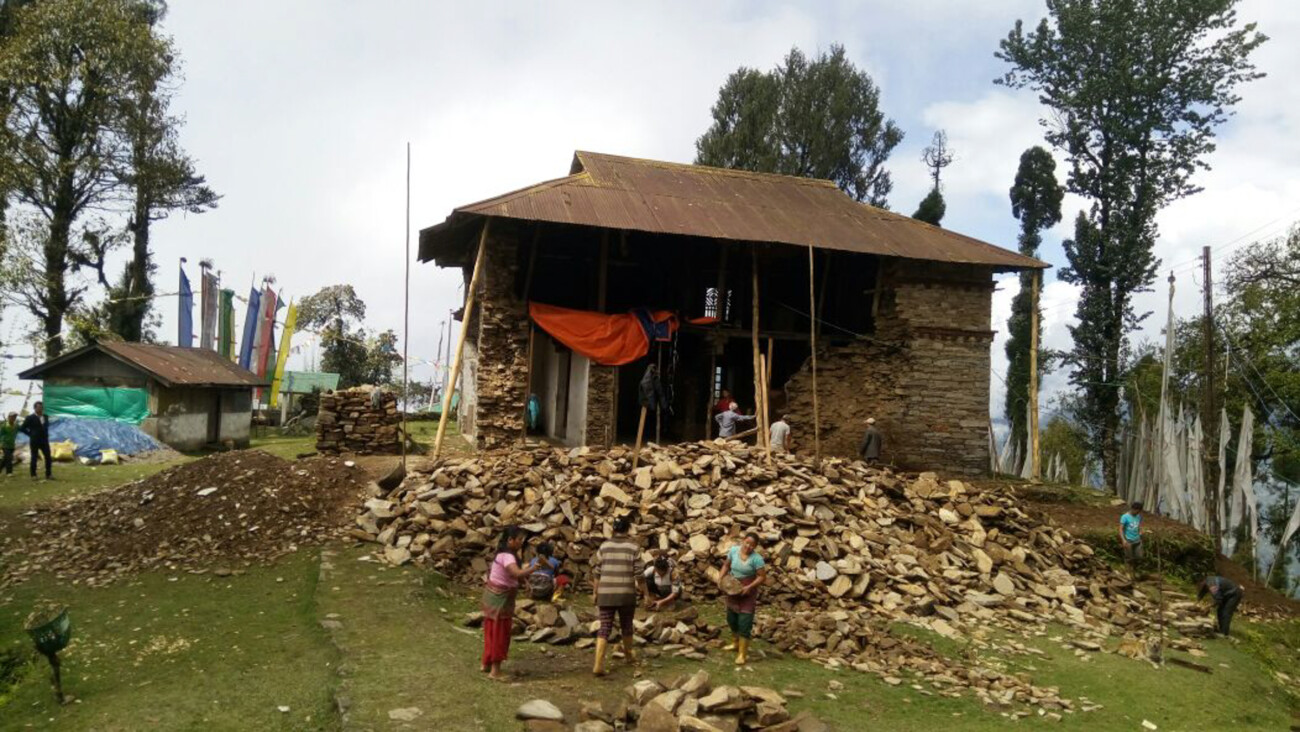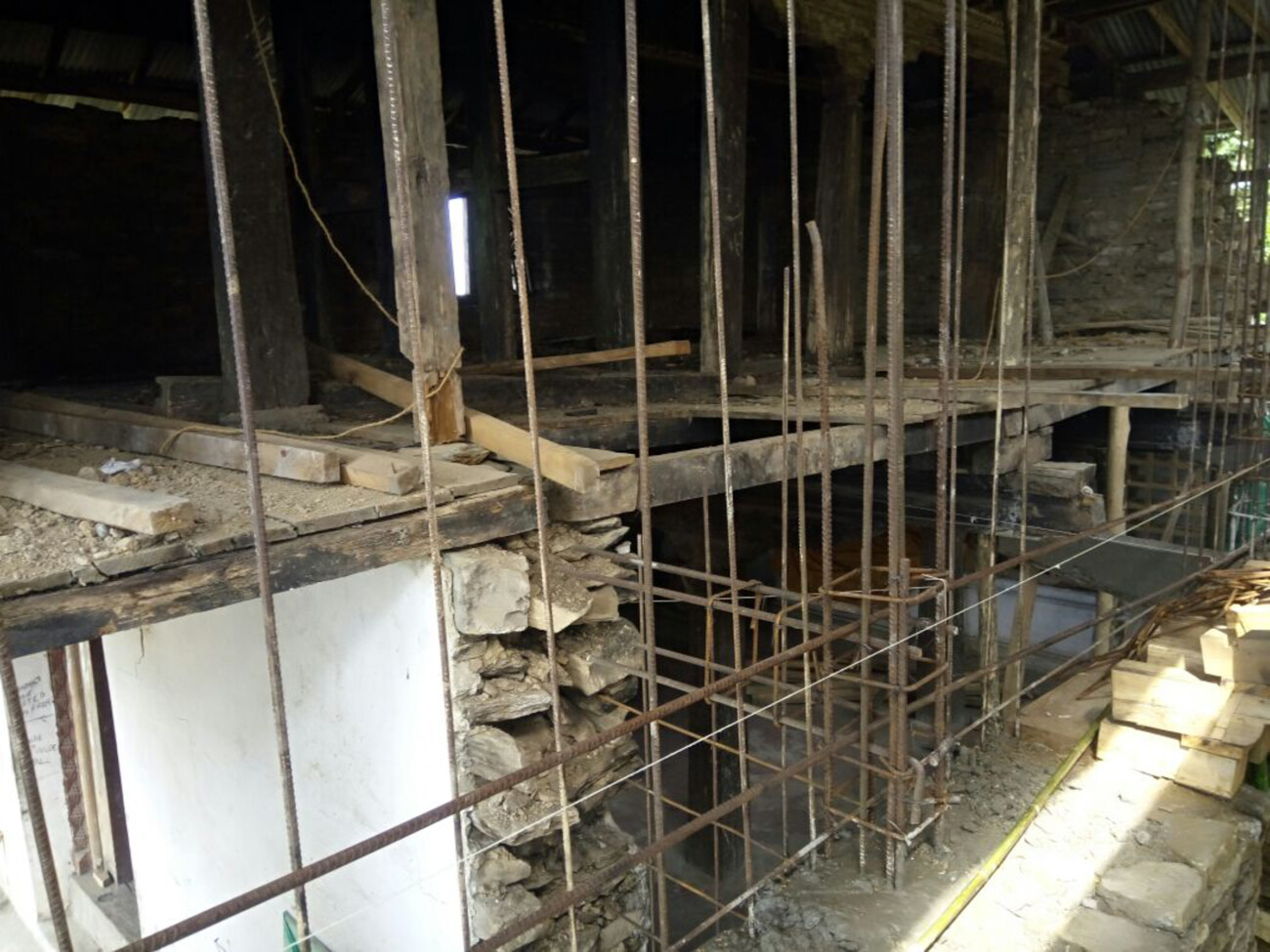The importance of Pemayangtse Monastery in the imagining of Sikkim as a Buddhist kingdom is well established. As prophesied by Guru Padmasambhava, the saint who took Buddhism to Tibet in the eighth century, Sikkim or Beyul, was the hidden sacred land where Dharma would flourish in the future. Now, Pemayangtse Monastery is the leading part of a religious complex with Dubdi Monastery at Yuksom, followed by Norbugang Chorten, Tashiding Monastery, the ruins of Rabdentse, the Sanga Choeling Monastery, and the Khecheopalri Lake.
The monastery, located at an elevation of 2,085 meters, is a three-storied structure. The walls in various floors are adorned with statues of saints and Rinpoches. It was damaged by earthquakes in 1913 and 1960, and has since been refurbished several times. The monastery belongs to the Nyingma order and a characteristic feature of the shrine is the statue of Padmasambahva and his two consorts. In the main prayer hall ( 139.35 square meters area), is the Dukhang or Lakhang. The main temple has colourfully painted doors and windows in Tibetan design motifs. The statue of Padmasambahva is seen here in his wrathful form as Dorje Phurba (Vajrakila) with multiple heads and arms. The monastery was built for ta-tshang, meaning ‘monks of pure Tibetan lineage’—monks who are celibate and without any physical blemish. Only the monks of Pemayangtse Monastery are entitled to the title ta-tshang or pure. The Lobey Dorjee, head lama of this monastery, traditionally anointed the Chogyals of Sikkim.

The descendants of the first four families are still deeply engaged with the preservation of traditions and culture represented by the monastery. These four original families trace their ancestry to one of the three sons of Khye Bumsa, Mi-tpon-rab married a Sakya lady and had four sons Zhan-po-tar, Tshes-bchu-tar, Nyi-ma Gyaspa and Guru-tashe. From these four brothers, the four chief families of Sikhim, known as sTong-hDu-Rus-bzi trace their descent. (The Gazeteer of Sikhim, HH Risley, pp. 9)
The monastery observes, among other regular rituals, the two main celebrations that include Lueden a weeklong prayer held annually when monks from all the monasteries of Sikkim congregate at Pemayangtse to recite the seven scriptures for the protection of Sikkim. On the final day a sacred scroll is unfurled for public viewing. The second, the celebration of Pang Lhabsol is particularly significant in reinforcing the spiritual connection between the people of Sikkim and the sacred land.
Gyalwa Lhatsum Chempo went on to have the most profound influence in the course of Sikkim’s history and is regarded as the main propagator of Buddhism in Sikkim.
When the three Niyangmapa masters, Gyalwa Lhatsum Chempo, Kathog Kuntu Zangpo and Ngadak Sempa Chempo arrived in Sikkim from three different directions in the first half of the seventeenth century, they found Sikkim still to be a hidden land. Gyalwa Lhatsum Chempo went on to have the most profound influence in the course of Sikkim’s history and is regarded as the main propagator of Buddhism in Sikkim. Being from the Nyingmapa sect he was also a master of Dzongchen, the teachings of the Great Perfection shared by both Nyingmapa and Bonpo sects.
When seeking entry into Demojong through the northern gate, a mountain pass to the south of Khanchendzonga—the Kangla on the Sikkim-Nepal border—Gyalwa Lhatsum Chempo disappeared for seven days. His disciples feared that he had perished amongst the precipices and began to mourn his death and built a Lamuney Mendang in his memory. As they were preparing to return, they heard Gyalwa Lhatsum Chempo’s thigh bone trumpet (a ritual instrument made out of human thigh bone) and waited for a further seven days. After three weeks Gyalwa Lhatsum Chempo arrived at the spot where the Lamuney Mendang had been built. He cut a path across the face of the cliff, and a road leading to Dzongri was opened.

The story goes that Khanchendzonga, the guardian deity, himself welcomed Gyalwa Lhatsun Chempo when he opened the Beyul. One of the first tasks that Gyalwa Lhatsun Chempo performed on his arrival was a thanksgiving ritual for the safe passage, dedicated to Dzonga and all the deities of the land. This ritual has now become an important annual event.
When Gyalwa Lhatsun Chempo proceeded to convert the indigenous Lepchas to Buddhism, ‘he did so by converting their sacred landscape and including its already sacred features within his Buddhist rendition of Sikkim’s geography. He composed the Neysol, a ritual text that is an offering to powerful sacred places, and is a celebration of Sikkim as Beyul, or sacred hidden land. And an offering ritual to Khangchendzonga (gangs snow, chen great, mdzod treasure, linga five) Sikkim’s mountain-god and all the deities of the land.’ (Denjongpa, pp. 23). Pang Lhabsol, ‘offering to the witness god’, a national shamanic ritual, celebrated people’s relationship with the sacred land and its deities. (Denjongpa, pp. 25). People believe that the image of Buddha representing long life, appeared on the mountain face and from the heart of this image flows a spring to form the Rathong glacier which is the source of Rathong Chu, the sacred river in West Sikkim.

Lepchas held their own rituals for Khanchendzonga long before the establishment of Sikkim as a Buddhist kingdom. Lhatsun Chempo incorporated the Lepcha rituals to become a joint celebration of the deities of the land, as in the joint performance of Pang Lhabsol. Kali Jhora Bongthing performed the ritual for Yabdue, the guardian deity of Sikkim’s Southern Gate, his abode above the Teesta, south of present day Sikkim. The Taso or Kongchen Bongthing performed a ritual for Kongchen Chyu, the Lepcha name for Khanchendzonga at the permanent open-air altar at Nung (Tingvong) in the Lepcha Reserve of Dzongu.
The third Chogyal, Chagdor Namgyal (1686-1716), believed to be the incarnate of Gyalwa Lhatsum Chempo, choreographed the dance performed by the lamas of Pemayangtse monastery. The dance later spread to different monasteries as a propitiating ritual, bringing into its repertoire the Pangtoed cham, a dance of the Dzonga’s soldiers performed by lay dancers.
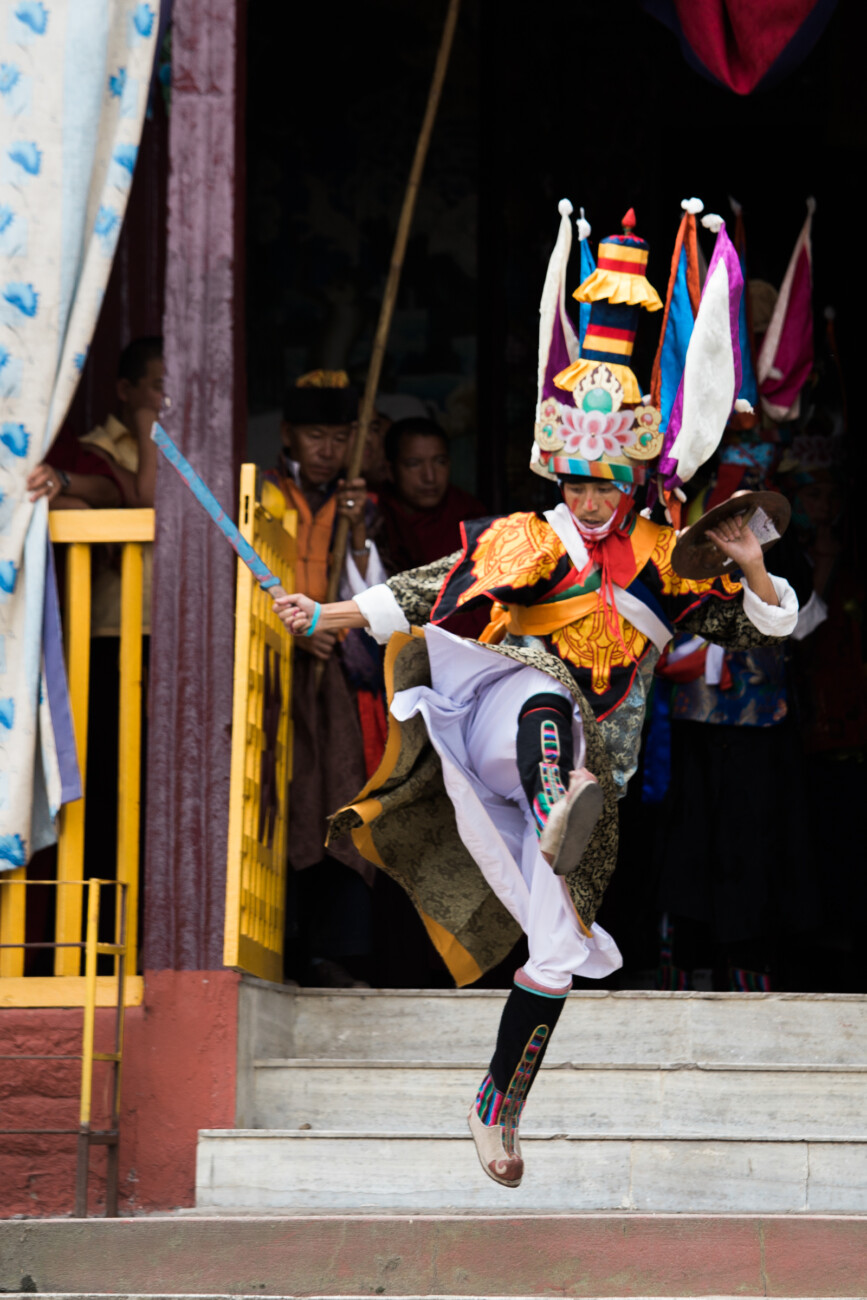
Every year, a group of Pemayangtse lamas hold a Neysol ritual at Dzongri on the fifteenth day of the seventh lunar month, and then proceed to Dabla Gang, the highest location in Dzongri, which has the shape of a natural altar facing Khanchendzonga. After this the lamas proceed to Du Tsen Lu Sum consisting of four chortens (cairns) dedicated to the four root guardians of Sikkim, where they offer prayers. A yak is offered to Dzonga and set free. The lamas then proceed to the lake of Kabur Lam Tsho where further rituals are held and then return to Dzongri to complete the Neysol ritual. (For a more detailed description of this ritual see Pang Lhabsol: Celebrating Sikkim’s Gurdian Deities). The prayers include descriptions of deities of each holy place and the main focus is on Khanchendzonga.
In the seventeenth century when the first Chogyal of Tibetan ancestry, Phuntsog Namgyal, was enthroned in Yuksom, the new rulers sought compliance from the Limbus and the Lepchas by signing the treaty of Lo-Mon-Tsong-Sum. This treaty assured equal treatment of the people in power-sharing and privileges. The powerful monastic order of Pemayangtse, made up of pure Tibetan blood, stipulated full participation of the Limbus and the Lepchas which translated into the latter adapting to the new religion of the rulers. The Lo-Mon-Tsong-Sum government called Lhade-medi government was a combination of the monastic order and the lay community. There were eighteen members who formed the Council. Each of the three communities had to send six members each for the monastic order and lay community. Under this government, one son from every family (preferably the second son) had to be sent to the monastery. The members of the three communities were exempted from paying tax. In lieu of this exemption, the communities had to maintain (adopt) their tradition and culture. Every home was required to have a lakhang, or an altar, where the head of the family had to lead the family in prayer. A butter lamp was to burn and seven bowls of fresh water were to be offered every morning, and removed in the evening. On special days, such as Buddha Purnima and national holidays, the community was required to attend the functions at the monastery.
In the eighteenth century Chagdor Namgyal took several initiatives to strengthen Buddhism in Sikkim. He granted a vast estate to Pemayangtse, bounded by three rivers—Rathong Chu on the North, Rangeet on the East and Kalej on the South, touching the Nepal and China borders. The proceeds from the estate were shared between the palace and the monastery, and this arrangement continues till this day, where the proceeds are shared between the monastery and the government.
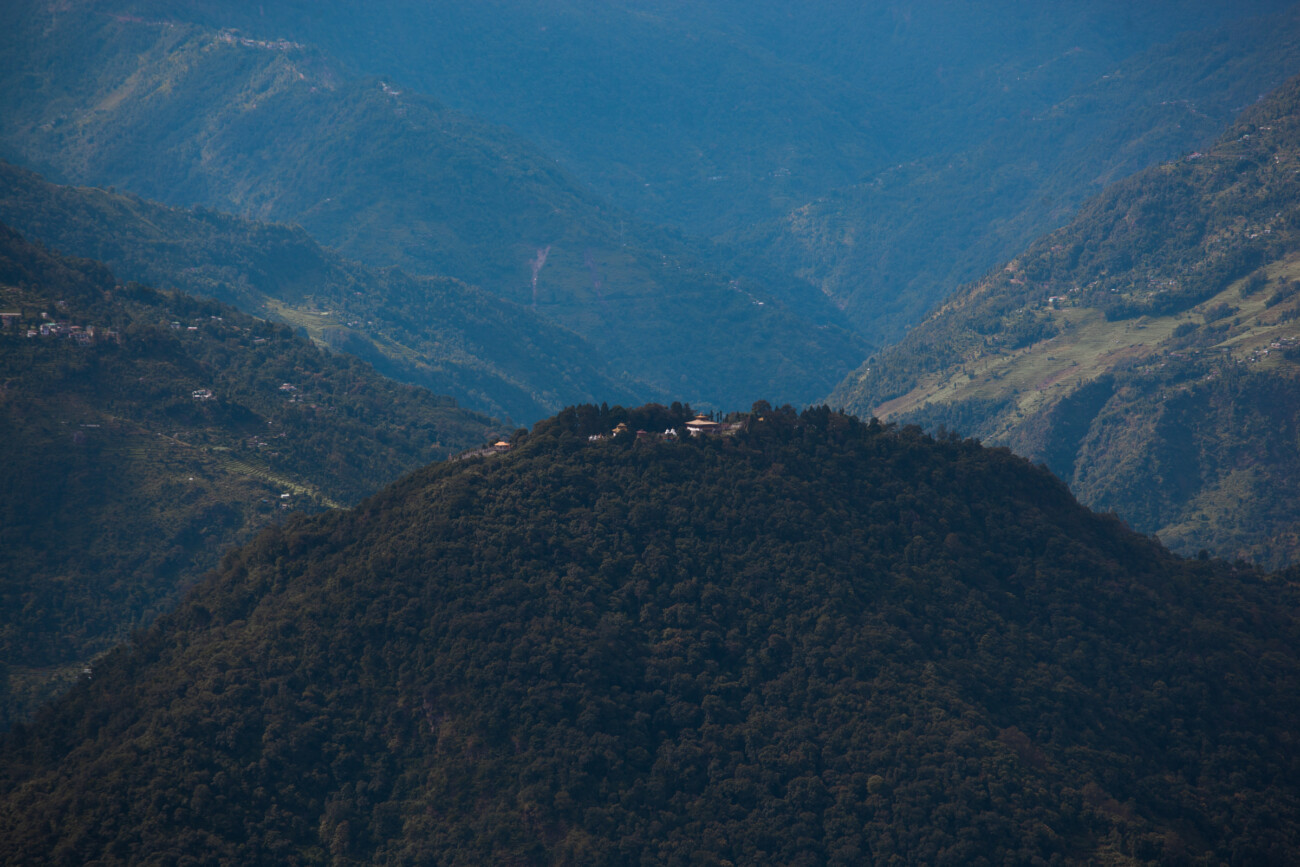
After the merger of Sikkim with India in 1975, the annual rituals suffered a setback. The festival of Pang Lhabsol, the ritual dances at the Palace Tsuklakhang, was discontinued. However, the Pemayangtse lamas who had traditionally held the royal rituals during the time of the kingdom were the first to reintroduce its full performance at their monastery in 1994.
In the mid-1990s an entirely new version and interpretation of the Pang Lhabsol celebration was introduced in the Gangtok bazaar, stressing the thirteenth century blood brotherhood between the Lepchas and the Bhutias, where Dzonga is invoked as a witness deity. Now the celebration is expanded to Rabong monastery where it has become a major festival with participations from locals and even tourists.
In 2009, late Lachen Rimpoche initiated its performance in Lachen’s Thangu monastery. The Tsuklalkhang Trust, established in 2000 revived the sacred ritual. The first Pang Lhabsol after all these years was performed in 2016 and the Tshuklakhang celebration revived the relationship of the people with the land. The scope of the rituals now symbolically includes all communities in Sikkim signifying unity among the people of Sikkim. According to Captain Yongda, who said in an interview that the ritual is observed not only to protect Denzong, but also the whole world. Thus, the ritual importance of Pemayangtse continues, albeit, in these changed circumstances.
References:
- Denjongpa, Anna Bllicki, Pang Lhabsol: Celebrating Sikkim’s Gurdian Deities, Namgyal Institute of Tibetology, Gangtok, Sikkim.
- Interviews with Captain Yongda.
- Interview with Ugen Chophel.
- The Gazeteer of Sikhim, Sikkim Nature Conservation Foundation, Gangtok, Sikkim India 1989 (Reprinted).
Photo Gallery
(Click to enlarge)
